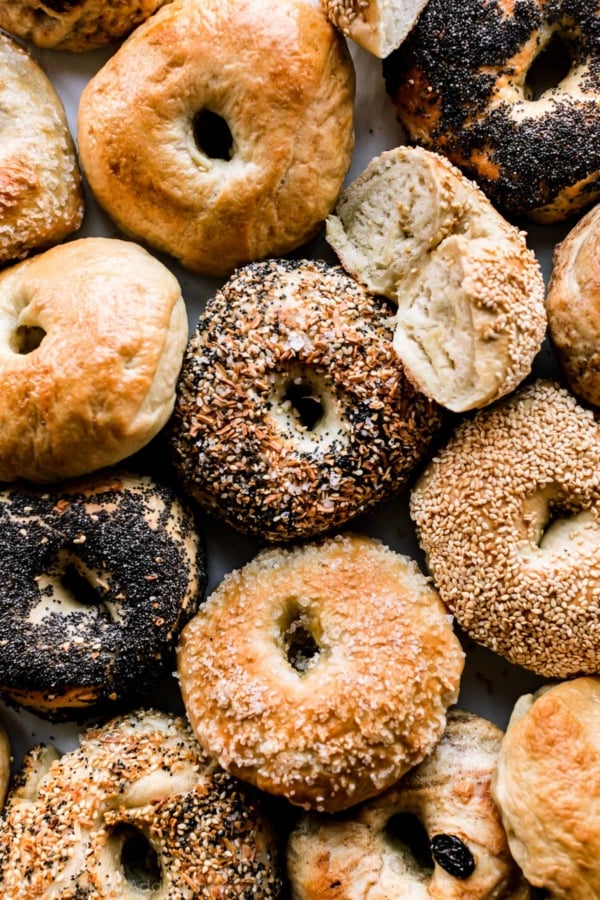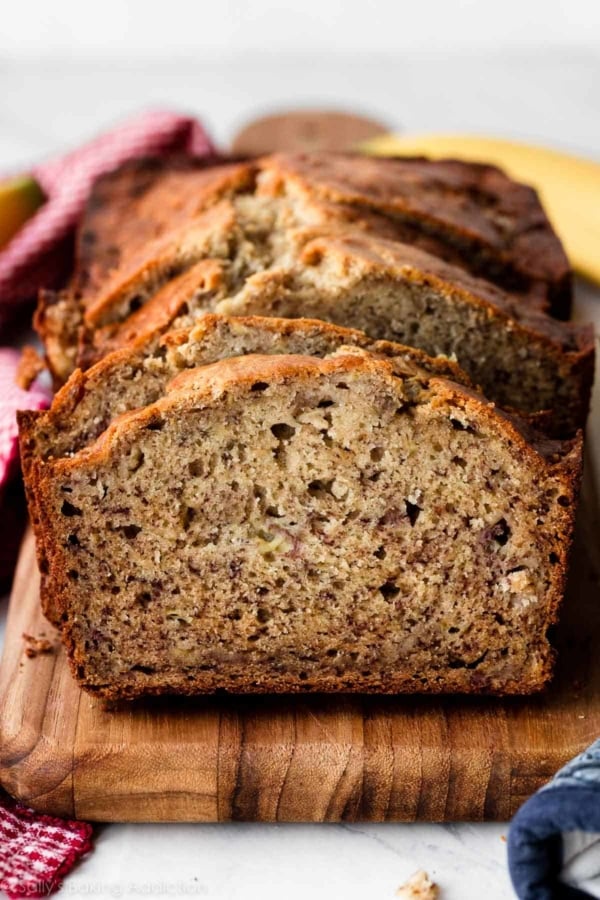Learn how to make homemade brioche, an irresistibly rich, buttery bread with a soft, tender crumb. This recipe is a 2-day baking project, since the dough rests in the refrigerator overnight to lower its temperature, as well as develop proper flavor and texture. A stand mixer fitted with a dough hook is essential for best success.

Reference my Baking with Yeast Guide for answers to common yeast FAQs.
What Is Brioche?
Brioche originated in France and stands out from other breads because it’s enriched with butter, eggs, and milk. The result is a bread that bakes up puffy, fluffy, flaky, and oh-so-soft. It’s a treat all on its own, and makes for truly indulgent grilled cheese or next-level French toast casserole!
Technically, brioche is a viennoiserie, which is a category of rich, sweet baked goods made with yeasted dough that falls somewhere between breads and pastries. Croissants, pain au chocolat, and croissant bread are also in this category. But unlike those, there are no lamination steps today.
One reader, Stanley, commented: “I’m very happy with this recipe. I’ve always wanted to make brioche but struggled with the texture and lightness. Thanks to the crucial instructions and tips, I’m pleased to say this recipe was my first success and I see it as a popular go-to for the future. Thank you so much, Sally and team! ★★★★★“
One reader, Patti, commented: “This brioche is amazing! It is soft, buttery, and tender. This recipe is a keeper! ★★★★★“
One reader, Lolly, commented: “Delicious brioche! I have made many loaves (retired pastry chef) and this one doesn’t disappoint. The technique for preparing the butter is especially helpful. It’s a good idea to have extra loaves on hand because brioche makes the best French toast. ★★★★★“

Ingredients You Need
You need 7 ingredients altogether. They’re the same ingredients in my soft dinner rolls, which is also a rich dough. However, brioche requires more butter, sugar, eggs… and a bit more time!
The other main difference you’ll see between this recipe for brioche compared with many of my yeast bread recipes is the temperature of the milk, eggs, and butter. We’ll get into that below, when I walk you through the steps.
- Flour: You need bread flour for this recipe. All-purpose flour is convenient for most, but bread flour produces the best structure here. There are no other changes to the recipe if you use all-purpose flour.
- Yeast: You need 2 and 1/4 teaspoons active dry yeast or instant yeast, which is 1 standard packet (7g).
- Sugar: Sugar feeds the yeast, increases its activity, and tenderizes the dough. Plus it gives this brioche its characteristic mildly sweet flavor.
- Salt: You can’t make flavorful bread without salt!
- Milk: For the softest brioche, use whole milk.
- Eggs: 3 eggs provides structure and richness.
- Butter: Butter promises a flavorful, soft, tender brioche. You’ll add it in later, a little at a time.

To learn how to make homemade brioche, I turned to the king. King Arthur Baking, that is; specifically, their Big Book of Bread, which is one of my favorite cookbooks for discovering the hows and whys of bread-making. The recipe you see below was adapted from the basic brioche in that book.
How to Make Homemade Brioche
Start by whisking all the dry ingredients together in the bowl of your stand mixer, then add in the milk and eggs.

Start the mixer on medium-low speed and let the dough hook mix it all together. The dough will come together slowly. Stop the mixer periodically to scrape down the sides of the bowl. The dough will look very shaggy at first, but just keep mixing, and eventually it should form a mass around the dough hook.
Trust the process.
Increase the mixer speed to medium, and let it run for 8–10 minutes. After 8 minutes, if the dough isn’t wrapped around the dough hook and slapping the sides of the bowl, add a little more flour—just a Tablespoon at a time—until it is. This long kneading time is developing the gluten network, creating strength and elasticity.
Again, trust the process.

A Key Step: Plasticizing the Butter
While the mixer is running, it’s time to take all your frustrations out on some innocent pats of butter. Isn’t baking fun??
Place a piece of parchment paper on top of a sturdy cutting board. Cut a cold stick of butter (113g/8 Tbsp) into 8 equal pieces, and lay them out on the parchment. Place another piece of parchment on top. Now use a rolling pin to pound the butter until it’s very thin, about 1/16th of an inch (about 1.6mm); you don’t want it any thicker than 1/8th inch (3mm), or it will be too difficult to incorporate into the dough.

Why do we pound the butter? Because we want the butter to be pliable enough to incorporate into the dough, but still cold so that it doesn’t raise the temperature of the dough when we add it in. This technique is known as plasticizing the butter, and it’s often used for pastry lamination.
When your dough has been kneaded for long enough and the butter has been thoroughly plasticized, it’s time to put it all together.
Add the Butter to the Dough
With the mixer running on medium-low speed, add the pieces of cold butter into the bowl, 2 pieces at a time. Wait for the butter to be completely incorporated into the dough before you add the next 2 pieces—this can take up to 2 minutes. If it’s not incorporating and sticking to the bowl, stop the mixer and scrape down the sides of the bowl, then try again.

Once all the butter has been incorporated, let the mixer run for another couple of minutes. The dough should be slapping the sides of the bowl, and it should look very smooth, shiny, and elastic.
When your brioche dough has reached this point, shape it into a ball and place it in a greased bowl:

Cover the bowl tightly and refrigerate it overnight, for at least 12 hours. This dough can fit into any schedule, because refrigerating for up to 48 hours is fine!
Shape the Brioche Loaf
There are many, many ways to shape brioche, but the one I’m showing you is the one that gave my team the best result: super tall, super fluffy, super flaky bread!
It is called Brioche Nanterre.
When you take the dough out of the refrigerator, you’ll notice it slightly rose and expanded. That’s expected. Also, the butter will have re-solidified and the dough will feel a lot more manageable to work with. It’s cold and easy to shape:

Divide the dough into 6 equal pieces and shape them into balls, the same way we shape sweet potato dinner rolls and oatmeal molasses dinner rolls. Take a piece and stretch the top of the dough while pinching and sealing the bottom. Make sure the dough balls are smooth on top and sealed on the bottom.

Place each dough ball into a greased loaf pan, staggering them a bit. See next photo.
Cover and let the dough rise at room temperature until it just reaches the top of the loaf pan. Depending on the temperature of your kitchen, this takes about 1 and 1/2 to 2 hours. Don’t get nervous if it takes a bit longer than 2 hours. The dough rises a little slower and not as high because it’s cold. But don’t worry—this brioche puffs up nice and tall in the oven!

When you’re ready to bake the brioche, brush the top of the loaf with egg wash, to get that beautiful golden sheen.
Baking & Cooling Homemade Brioche
Expect this brioche loaf to bake for around 35–40 minutes; most of our test loaves needed the full 40 minutes.
Let the loaf rest in the pan for about 10 minutes, then transfer it to a wire rack to cool for at least an hour. Patience pays off here because as the loaf cools, the crumb sets, and you’ll get neat, fluffy slices. That said, if you just can’t resist sneaking a warm slice, go for it. Just know the texture will be a little softer than when it’s fully cooled. And have some butter, homemade honey butter, or cinnamon butter at the ready!!


Success Tips for Making Brioche
After many rounds of testing, here are the most important things my team and I learned:
- Use a stand mixer: Brioche requires a really long mixing time, so I strongly recommend using a stand mixer (fitted with a dough hook) to make it. It is very difficult (and a lengthy process!) to make brioche without one.
- Keep things cold: The milk, eggs, and butter should all be cold when you begin. The long mixing time means the dough will gradually warm up. Keep the butter in the refrigerator until you’re ready to add it to the dough, and pound it with a rolling pin between sheets of parchment paper to make it pliable (but still cool).
- Give it a rest: Once the dough is kneaded and ready to rise, cover it tightly and refrigerate it for at least 12–16 hours. The buttery dough will be very soft and difficult to handle, and you need to allow the butter time to re-solidify, so the dough will be workable and easy to shape. (You can actually leave it in there for up to 48 hours, so that allows for flexibility for when you bake it.) The cold air also slows down the yeast activity and fermentation, which enhances the bread’s flavor.
- Use a kitchen scale: In addition to using a food scale to weigh the ingredients for the most precise measurements, it really comes in handy for dividing the dough into 6 evenly sized pieces. Simply weigh the entire ball of dough, then divide that number by 6 to determine how much each dough ball should weigh.
- Tent with foil: Loosely tent the loaf with aluminum foil halfway through baking. This prevents the top of the loaf from burning before the center has fully baked.
- Let it cool: As tempting as it is to slice into warm, freshly baked brioche, it’s best to wait. Cutting too soon can make the inside seem dense or gummy because the steam hasn’t had time to escape. This is true for most breads, including yeast bread and quick bread.
You can use either American or European butter in brioche. European butter has a touch more butterfat (about 82–85% compared to 80% in American), so the flavor is a little richer and creamier. That extra bit can really shine in a bread like brioche, which is already loaded with butter, eggs, and milk. That said, the difference isn’t huge. If European butter is what you have, go for it! Otherwise, American butter will bake up a perfectly soft, fluffy loaf. It’s what we used in many test loaves.
Yes, absolutely. You can divide the dough into 12 smaller rolls, rather than 6 larger pieces. Arrange the shaped rolls in a greased 9×13-inch pan. Proceed with step 8 below. Shorten the bake time to around 25–28 minutes. You can also bake the rolls separated on a lined baking sheet; this style produces excellent hamburger and sandwich buns. See recipe Note below.
My team and I tested this dough in a braided design in the loaf pan. The finished bread was considerably dense, due to the tight braiding technique. For the tallest, fluffiest brioche, I recommend the brioche nanterre shape instructed in the recipe below.


Homemade Brioche
- Prep Time: 15 hours (includes rises)
- Cook Time: 40 minutes
- Total Time: 15 hours, 40 minutes
- Yield: 1 loaf; 8-10 slices
- Category: Bread
- Method: Baking
- Cuisine: French
Description
Learn how to make homemade brioche, an irresistibly rich, buttery bread with a soft, tender crumb. This recipe is a 2-day baking project, since the dough rests in the refrigerator overnight to lower its temperature, as well as develop proper flavor and texture. A stand mixer fitted with a dough hook is essential for best success. Be sure to use cold milk, eggs, and butter. Reference my Baking with Yeast Guide for answers to common yeast FAQs.
Ingredients
- 3 and 1/4 cups (423g) bread flour (spooned & leveled), plus more as needed
- 2 and 1/4 teaspoons (7g) active dry or instant yeast (1 standard packet)
- 1/4 cup (50g) granulated sugar
- 1 and 1/2 teaspoons salt
- 1/2 cup (120ml) whole milk, cold
- 3 large eggs, cold
- 1/2 cup (113g; 8 Tbsp) unsalted butter, cold
- egg wash: 1 large egg beaten with 1 Tablespoon (15ml) milk
Instructions
- Make the dough: In the bowl of a stand mixer fitted with a dough hook attachment, whisk together the flour, yeast, sugar, and salt. Add the milk and eggs, and mix on medium-low speed for 3 full minutes, until the dough comes together and forms a rough mass around the dough hook. It will be shaggy at first, but just keep mixing until it comes together. Stop the mixer and scrape down the sides of the bowl as needed.
- Increase the speed to medium and let the mixer run for 8–10 minutes. Do not shorten this time. The dough should wrap itself around the dough hook and be slapping the sides of the bowl. If that isn’t the case after about 8 minutes, add a little more flour, 1 Tbsp at a time, and keep mixing.
- Plasticize the butter: Place a sheet of parchment paper on a sturdy cutting board. Cut the cold butter into 8 equal pieces. Lay the pieces out on the parchment. Place a second sheet of parchment paper on top of the butter. Using a rolling pin, pound the butter to flatten it to about 1/16th of an inch thickness, or about 2mm. If the dough is not yet ready for the next step, transfer the butter, still between the sheets of parchment, to the refrigerator. The butter must be cold.
- With the mixer running on medium-low speed, add the butter, 2 pieces at a time. Use a knife or offset spatula to scrape the pieces of butter off the parchment paper and add them to the mixing bowl. Wait until the butter has completely incorporated into the dough before you add the next 2 pieces—this can take about 2 minutes. If the butter gets stuck to the side of the bowl, stop the mixer and scrape it down with a spatula. Once all 8 pieces of butter have been added, increase the speed to medium and let the mixer run for another 2 minutes (again, the dough should be slapping the sides of the bowl), until the dough is smooth, shiny, and elastic. It will be very soft.
- Refrigerate the dough: Grease a large bowl with butter, oil, or nonstick spray. Shape the dough into a ball and place it in the bowl, turning it to coat the dough in the butter/oil. Cover tightly and refrigerate for at least 12–16 hours, or up to 48 hours.
- Grease a 9×5-inch loaf pan.
- Shape the brioche: Remove the dough from the refrigerator and turn it out onto a lightly floured surface. Divide the dough into 6 equal pieces. A bench scraper is always helpful for cutting dough. (Tip: If you have a kitchen scale, weigh the dough, then divide that number by 6 so you know how much each piece of dough should weigh. For example, if the dough weighs 850g, aim for each piece of dough to weigh around 140–145g.) Shape each piece into a smooth ball, and place in the prepared loaf pan, staggering the dough balls in a zigzag pattern.
- Cover the loaf lightly and let it rise at room temperature for 1.5 to 2 hours until it’s puffy and just reaches the rim of the pan.
- Adjust an oven rack to a lower position and preheat the oven to 350°F (177°C).
- When the brioche has risen to the rim of the pan, brush the top of the loaf with egg wash. Bake for 35–40 minutes, until golden brown on top. For a more accurate test, insert an instant-read thermometer into the brioche; it’s done when the internal temperature reaches 195°F (91°C). If you notice the top browning too quickly, loosely tent the pan with aluminum foil. (I always tent aluminum foil over the loaf around the 20-minute mark.)
- Let the brioche cool in the pan set on a cooling rack for at least 10 minutes, then carefully flip the bread out of the pan and onto the rack to continue cooling. Cool for at least 1 hour before slicing. (The crumb sets as it cools, giving you neat, fluffy slices—but if you sneak a warm piece, just know it’ll be extra soft!)
- Cover leftover brioche tightly and store at room temperature for up to 5 days or in the refrigerator for up to 1 week.
Notes
- Make Ahead Instructions – Overnight: See step 5. The dough must rest in the refrigerator for at least 12–16 hours, or up to 48 hours.
- Make Ahead Instructions – Freezing: It is best to freeze the brioche dough after it has had its bulk fermentation, which is the refrigeration step (step 5). To freeze, shape the dough as indicated in step 7. Wrap each ball of dough in plastic wrap and place them all in a freezer-safe container or bag. Freeze for up to 3 months. Thaw the dough in the refrigerator overnight, then let the dough balls come to room temperature, place in the greased loaf pan, and proceed with step 8.
- Special Tools (affiliate links): Electric Stand Mixer | Silicone Spatula | Rolling Pin | 9×5-inch Loaf Pan
- Flour: I recommend using bread flour. All-purpose flour is convenient for most, but bread flour produces a chewier loaf of bread and I highly recommend it. If you can’t pick up a bag of bread flour, all-purpose is great in a pinch. The bread is still soft no matter which you use. I don’t recommend whole wheat flour because it doesn’t have the same baking properties as white flour or bread flour (the gluten levels are different). If you wish to use whole wheat flour, try my recipe for whole wheat bread instead.
- Yeast: You can use active dry or instant yeast in this recipe. Follow all of the same instructions. Reference my Baking with Yeast Guide for answers to common yeast FAQs.
- Milk: I recommend using whole milk for the best, richest-tasting bread. Lower-fat or nondairy milks work in a pinch. Do not use nonfat milk.
- Doubling this recipe: For best results, I recommend making two separate batches of dough.
- Can I make this dough into smaller brioche rolls? Yes, absolutely. You can divide the dough into 12 smaller rolls, rather than 6 larger pieces. Arrange the shaped rolls in a greased 9×13-inch pan. Proceed with step 8. Shorten the bake time to around 25–28 minutes. You can also bake the rolls separated on a lined baking sheet; this style produces excellent hamburger and sandwich buns. Bake time is around 25 minutes.
- Can I braid this dough instead? My team and I tested this dough in a braided design in the loaf pan. The finished bread was considerably dense, due to the tight braiding technique. For the tallest, fluffiest brioche, I recommend the shape instructed (2 staggered rows of the dough balls in the loaf pan), which is called Brioche Nanterre.
Recipe adapted from Basic Brioche Dough in Big Book of Bread by King Arthur Baking Company



















Reader Comments and Reviews
Hi! I tried making this for the first time and I’ve never made bread before, only dessert loaves. I followed everything to a T. Brand new bread flour, brand new yeast. I just took the dough out of the fridge from overnight and it hasn’t risen at all. Is this okay? Thanks for your response!
Hi Danielle! We would give it more time to rise until it’s puffy before baking. Is your kitchen a little cold today?
I love this recipe. I made the best bread EVER with this recipe. I will be making more. Thank you!
Can the sugar be reduced in this recipe?
Hi Lois! Sugar feeds the yeast, increases its activity, and tenderizes the dough. Plus it gives this brioche its characteristic mildly sweet flavor. You could try slightly reducing it, but results will vary.
Can I make chocolate chip croissant filled with Nutella with the brioche dough recipe?
Let us know if you try! You may also love our chocolate croissants recipe.
Hello! Would you mind explaining the process and reasons you chose to do certain steps? I’ve seen other recipes do an initial proof before a cold rest, and it seems like you skipped that part. And the other recipes also say the butter should be soft to touch, but yours is cold. There are so many different possibilities that I get a little lost as to WHY some other better than others!
Hi Elena! Great questions. Brioche recipes can vary a lot, but we developed this recipe to give maximum structure and flavor without as much fuss. I skip the initial room-temperature rise because the long, slow overnight rise in the refrigerator does the same job, just slower and more gently. It allows the dough to develop flavor without risking over-proofing in a warm kitchen. And I call for cold butter because it emulsifies into the dough more cleanly; very soft butter can make brioche greasy and harder to handle, especially for home bakers. There’s no single “right” method, just different approaches. We find this one keeps the dough strong and manageable.
I tried this recipe this morning and I must have done something wrong. I followed the directions to a T but when it came time to put it into the fridge, it felt dense and heavy. What could have gone wrong? I’m so disappointed ☹️
Hi Deborah! We’re happy to help. Did your dough look like the step by step photos and video tutorial above? A dense dough can be caused by too much flour in the dough. How did you measure the flour? Make sure to spoon and level (instead of scooping) to avoid packing in too much flour into your measuring cups – or use a kitchen scale. You can read more about properly measuring baking ingredients in this post.
This was absolutely wonderful bread!!!!!! I made extra large rolls with it, and came out awesome.
Love your recipes! thank you
Kim
I just put my dough in the refrigerator but I am wondering if it would make a difference to bake it in a glass bread dish. I know sometimes they recommend a different temperature. I am anxious to see how it turns out tomorrow.
Hi Mary, no need to change the temperature, but bake time may take a few minutes longer. Keep a close eye on it. Hope you enjoy the bread!
I made this today, well started it yesterday & oh my goodness, this has to be the easiet, tastiest bread I’ve ever made!!
I made Sally’s cinnamon butter for it, which is also amazing!!
This will definitely be going on my menu on a regular rotation.
Even if you aren’t a baker or intimidated with making bread, you have to try this.
I don’t think it could be any easier & the directions are straightforward.
Thank you for such a great recipe!
Wondering if this can be done in a bread machine (zojirushi)?
Hi Cristy, we haven’t tested it, but let us know if you do!
Question: Could I add vital wheat gluten to all purpose flour to mimic bread flour?
Love your book! I’ve given it as a gift 2x already.
I do this with all breads I make. I’m sure would be fine. If you’re going by weight, I’d add the called for amount of flour and then 2-4% vital wheat gluten
Hi Laurie, we are so glad you’re enjoying the cookbook! We haven’t tested that swap for bread flour, so we’re unsure of the exact results and ratios needed. If you do try it, please let us know how it goes!
I just made this recipe for the first time. I added mini chocolate chips in the final minute of kneeding. It is utterly delicious. The texture is just perfect. Thank you Sally!
I’m so excited to make this loaf! Can I expect the exposed dough be a little dried out after overnight in the fridge? I tried a different recipe in the past and even though it was tightly covered, the proofed dough had a dry skin on top. I want to make sure I’m doing it right.
We instruct you to coat the dough ball in butter/oil – this helps prevent a skin forming. Make sure to very tightly cover it. Happy baking!
Will this be a large enough loaf to make the apple cider French toast from this site? I planned to just buy a loaf, but this sounds too good to pass up!
Hi Allison, Yes, this brioche is fantastic in that recipe. Let us know if you give it a try!
Hi do you know what I can substitute for the milk to make it dairy free
Hi Nathalie, you can use a non-dairy milk if needed.
I made this recipe, and the bread was delicious! However, my crust was a little too thick and hard. Any ideas as to what might have caused this?
Hi Aimee, so glad you enjoyed the brioche. A thick or hard crust usually comes from the loaf baking a little too long or at a slightly hotter temperature than needed. Ovens can run warm, so if you haven’t already, try checking with an oven thermometer and consider reducing the bake time by a few minutes next round. You can also lightly tent the loaf with foil toward the end of baking to prevent the crust from darkening too much. Brushing with egg wash is important for color, but brushing on too heavily can sometimes contribute to a thicker crust. A light, even coat works best.
When does adding the plasticized butter take place? Is it 13 minutes (initial 3 mins + 8-10mins) after mixing ? If adding the 8 pieces of butter takes 8+2 mins total, then the grand total mixing time is 23 minutes?
Hi Paya, that is correct. The plasticized butter is added in step 4, so after the 2 initial mixing periods in steps 1 & 2. You’ll mix in the butter 2 pieces at a time, which can take about 2 minutes each time.
Is it a must to have a mixer with a dough hook? I do not and have been baking bread for some time by mixing by hand.
It’s definitely possible, but quite a workout! Brioche dough is very rich with butter and eggs, which makes it sticky and much more difficult to knead by hand. Without a stand mixer, you’ll need a lot of patience and elbow grease. Kneading, while working in the cold butter, will likely take 20+ minutes to properly develop the gluten. If you’re up for the challenge, go for it, but we really recommend a stand mixer for best results.
Absolutely spectacular!! You are an amazing baker! Every single recipe I’ve made from your website is stunning and delicious!! My family raves, and I always say these recipes are from Sally’s Baking Addiction she deserves all the credit! Thank you for sharing and all that you do to inspire all of us to get into the kitchen and try new recipes. <> Jodi Campbell – Canada